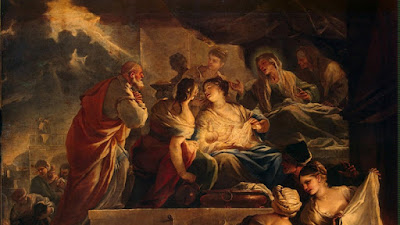Commemoration (1954 Calendar): July 10
Today is the Feastday of the Seven Holy Brothers. The Roman widow Felicitas and her seven sons were martyred around the year 162 AD for the Faith. Pope Gregory the Great said of her, "She was more than a martyr, for seeing her seven children martyred before her eyes, she was in some sort a martyr in each of them."
A century later, Rufina and Secunda, daughters of a wealthy Roman, refused to marry two suitors who had apostatized from the Christian religion. For this, they were scourged and beheaded. May these all too often forgotten martyrs intercede for us on this day of their commemoration.
The Catholic Encyclopedia, Volume XIII states:
Saints Rufina and Secunda, Roman martyrs, who according to the legendary Acts (Acta SS., July, III, 30-1) suffered in 287 during the Aurelian persecution. Their place of burial was at the ninth milestone of the Via Cornelia, as is stated in the Berne manuscript of the "Martyrologium Hieronymianum" (ed. De Rossi-Duchesne, 89). These martyrs are also recorded in the Itineraries of the seventh century as on the road just mentioned (De Rossi, "Roma sotterranea", I, 18283). Pope Damasus erected a church over the grave of the saints. The town on this spot named after St. Rufina became the see of one of the suburbicarian dioceses that was later united with Porto (cf. Allard, "Histoire des Persécutions":, III, 96).And Butler's Lives of The Saints states:
According to their unhistorical "acts", these were sisters, daughters of Asterius, a man of senatorial rank in Rome. They were engaged to be married, the one to Armentarius, the other to Verinus, who were also Christians. But when the persecution of the Emperor Valerian fell upon the Church, these two men apostatized. The two girls refused to follow their example and fled secretly from Rome. Their flight being soon discovered, they were overtaken not far from the city and haled before the perfect, Junius Donatus. He imprisoned them with the object of making them apostatize, and when he found that they were unmoved either by arguments or threats, he ordered Rufina to be scourged; whereupon Secunda cried out, "Why do you judge my sister to honour and me to dishonour? Be pleased to beat us both together, for we declare that Christ is God." After they both had been tortured in divers ways, they were put to death by beheading. A pagan lady named Plautilla gave their bodies burial at a spot eleven miles from Rome on the Aurelian Way, and herself became a Christian from their example. The place where they lay was at that time called Silva Nigra, the Black Forest, but from these martyrs that name was changed to Silva Candida, the White Forest. A church was built over their tomb and a town grew up around it, which also was called Silva Candida, or Santa Rufina; it was made an episcopal see and became appurtenant to the cardinalate in after years. The relics of the martyrs were translated in 1154 to the Lateran basilica, near the baptistery of Constantine. The church dedicated in honour of SS. Rufina and Secunda in the City purports to be built over the site of their dwelling-house. Except their existence, their martyrdom and their early cultus nothing is certainly known of these maidens.Collect:
O Lord, we pay honor to the bravery of Your glorious Martyrs in bearing witness to You. Grant that we may feel the power of their intercession with You. Through our Lord . . .
















